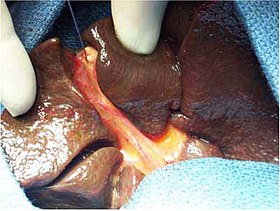ବିଲିୟାରି ଆଟ୍ରେସିଆ
ବିଲିୟାରି ଆଟ୍ରେସିଆ ରୋଗରେ ଯକୃତ ଭିତରେ ତଥା ବାହାରେ ଥିବା ପିତ୍ତନଳୀ ବା ବାଇଲ ଡକ୍ଟଗୁଡ଼ିକ ଜୀର୍ଣ୍ଣ ହୋଇଯାଏ | [୪] [୫] ଜୀବନର ପ୍ରଥମ କିଛି ମାସର ଲକ୍ଷଣ ଆରମ୍ଭରେ ସାଧାରଣତଃ ହଳଦିଆ ଚର୍ମ, ଧୂସର ରଙ୍ଗର ମଳ ଏବଂ ଯକୃତ ବୃଦ୍ଧି ସହିତ ହୋଇଥାଏ | [୨] [୬] ପୁଷ୍ଟିହୀନତା, ସିରୋସିସ୍ ଏବଂ ଯକୃତ ବିଫଳତା ଆଦି ପ୍ରତିକ୍ରିୟା ହୋଇପାରେ | [୭]
| Extrahepatic biliary atresia | |
|---|---|
| Extrahepatic ductopenia, progressive obliterative cholangiopathy | |
 Intraoperative view of complete extrahepatic biliary atresia[୧] | |
| ବିଭାଗ | General surgery |
| ଲକ୍ଷଣ | Yellowish skin, clay colored stool, enlargment of the liver[୨] |
| ଆକ୍ରାନ୍ତ ସମୟ | First few months of life[୩] |
| କାରଣ | Unknown[୨] |
| ରୋଗ ନିର୍ଣ୍ଣୟ ପଦ୍ଧତି | Suspected based on blood tests and medical imaging, confirmed by liver biopsy or cholangiography[୩][୨] |
| ସଠିକ ରୋଗ ନିର୍ଣ୍ଣୟ | Alagille syndrome, alpha-1-antitrypsin deficiency[୩] |
| ଚିକିତ୍ସା | Surgery[୨] |
| ପୁନଃପୌନିକ | 1 in 15,000 newborns (Europe, N. America)[୩] |
ଏହାର କାରଣ ବାରମ୍ବାର ଜଣା ପଡିନାହିଁ | [୫] ବେଳେବେଳେ ଏହା ଅନ୍ୟାନ୍ୟ ଜନ୍ମ ଦୋଷ ସହିତ ଥାଇପାରେ, ଯାହା ଭ୍ରୁଣୀୟ ବିଲିୟାରି ଆଟ୍ରେସିଆ (embryonic biliary atresia) ଭାବରେ ଜଣାଶୁଣା | [୭] ଅନ୍ତର୍ନିହିତ ପ୍ରଣାଳୀରେ ପିତ୍ତ ନଳୀଗୁଡ଼ିକର ପ୍ରଦାହ ହୋଇଥାଏ । [୬] ରକ୍ତ ପରୀକ୍ଷା ଏବଂ ଡାକ୍ତରୀ ଇମେଜିଙ୍ଗ କରି ରୋଗ ସନ୍ଦେହ କରାଯାଏ ଓ ଯକୃତ ବାୟୋପ୍ସି ବା କୋଲାଞ୍ଜିଓଗ୍ରାଫି ଉପରେ ଆଧାର କରି ରୋଗ ନିଧାର୍ଯ୍ୟ କରାଯାଇପାରେ। [୩] [୨]
ଏହାର ଏକମାତ୍ର ପ୍ରଭାବଶାଳୀ ଚିକିତ୍ସା ହେଉଛି ଅସ୍ତ୍ରୋପଚାର |[୫] ଦୁଇ ବିକଳ୍ପ ଅଛି ଯଥା: କାସାଇ ପ୍ରଣାଳୀ କିମ୍ବା ଯକୃତ ପ୍ରତିରୋପଣ | [୨] ଅସ୍ତ୍ରୋପଚାର ବିନା ୩ ବର୍ଷରୁ ଅଧିକ ବଞ୍ଚିବା ହାର ୧୦%ରୁ କମ୍ ଅଟେ | [୨] ଅସ୍ତ୍ରୋପଚାର ସତ୍ତ୍ୱେ ବ୍ୟକ୍ତିର ନିଜସ୍ୱ ଯକୃତ ସହିତ ଦୀର୍ଘକାଳ ବଞ୍ଚିବା ସମୟ ପ୍ରାୟ ୨୫% ଅଟେ | [୬]
ୟୁରୋପ ଏବଂ ଉତ୍ତର ଆମେରିକାରେ ପ୍ରାୟ ୧୫,୦୦୦ ନବଜାତ ଶିଶୁମାନଙ୍କ ମଧ୍ୟରୁ ଜଣକର ବିଲିୟାରି ଆଟ୍ରେସିଆ ହୁଏ | [୬] [୭] ଏସିଆରେ ଏହା ଏକ ସାଧାରଣ ରୋଗ ଓ ତାଇୱାନରେ ପ୍ରାୟ ୨,୭୦୦ ଲୋକରେ ଜଣେ ପ୍ରଭାବିତ ହେବା ଦେଖାଯାଏ। [୮] ୧୮୧୭ ମସିହାରେ ଜନ ବର୍ଣ୍ଣ ଏହି ରୋଗ ବିଷୟରେ ପ୍ରଥମେ ବର୍ଣ୍ଣନା କରିଥିଲେ | [୫] ସାମ୍ପ୍ରତିକ ଅସ୍ତ୍ରୋପଚାର ଚିକିତ୍ସା ବିଧି ୧୯୫୦ ଦଶକରେ ରୁଜୁ ହୋଇଥିଲା | [୨]
ଆଧାର
ସମ୍ପାଦନା- ↑ Chardot, Christophe (2006). "Biliary atresia". Orphanet Journal of Rare Diseases. 1: 28. doi:10.1186/1750-1172-1-28. PMC 1560371. PMID 16872500.
{{cite journal}}: CS1 maint: unflagged free DOI (link) - ↑ ୨.୦ ୨.୧ ୨.୨ ୨.୩ ୨.୪ ୨.୫ ୨.୬ ୨.୭ ୨.୮ Siddiqui, AI; Ahmad, T (January 2020). "Biliary Atresia". PMID 30725947.
{{cite journal}}: Cite journal requires|journal=(help) - ↑ ୩.୦ ୩.୧ ୩.୨ ୩.୩ ୩.୪ "Orphanet: Isolated biliary atresia". www.orpha.net. Archived from the original on 18 September 2020. Retrieved 13 February 2021.
- ↑ "Biliary atresia | Genetic and Rare Diseases Information Center (GARD) – an NCATS Program". rarediseases.info.nih.gov. Archived from the original on 19 March 2021. Retrieved 13 February 2021.
- ↑ ୫.୦ ୫.୧ ୫.୨ ୫.୩ Siddiqui, AI; Ahmad, T (January 2020). "Biliary Atresia". PMID 30725947.
{{cite journal}}: Cite journal requires|journal=(help) - ↑ ୬.୦ ୬.୧ ୬.୨ ୬.୩ "Orphanet: Isolated biliary atresia". www.orpha.net. Archived from the original on 18 September 2020. Retrieved 13 February 2021.
- ↑ ୭.୦ ୭.୧ ୭.୨ "Definition & Facts of Biliary Atresia | NIDDK". National Institute of Diabetes and Digestive and Kidney Diseases. Archived from the original on 17 January 2021. Retrieved 13 February 2021.
- ↑ Carroll, Will (2016). Surgery, Orthopaedics, Connective Tissue & Bone E-Book: Prepare for the MRCPCH. Key Articles from the Paediatrics & Child Health journal (in ଇଂରାଜୀ). Elsevier Health Sciences. p. PT62. ISBN 978-0-7020-7089-1. Archived from the original on 2021-08-28. Retrieved 2021-02-13.